

15 July 1410
The Teutonic Knights are defeated by the Polish-Lithuanian forces: it is the beginning of the end for the order.
TANNENBERG

The first source about a certain "teutonic brotherhood" dates back to 1143 when it inspired to orders already operating in the Holy land. But the Foundation of the "Ordo Domus s. Mariae in East Jerusalem" or "Deutsche Orden" goes back to 1190, when some merchants of Bremen and Lübeck thought to use it as defense of those cities and comfort to sick or wounded Crusaders into battle.
In 1198 the Order obtained recognition of the rule by the Pope innocent III and in 1199 was adopted the white mantle uniforms with a black cross superimposed that become their symbol of battle in their centuries-old history. Thanks to the benevolence of Frederick II and the Pope, together with the granting of Conrad, Duke of Masovia, the Teutonic Knights settled first at Kulm, pagan lands of Prussia, then thanks to the growing number of followers and of asset brought from those, became the sovereign State in that region, subjugating the disorganised and undeveloped local populations.
The expansions in the Baltic territories increased in subsequent years, town as Danzig, Konigsberg and Brandenburg became Teutonic. Also entire areas were annexed as the Pomerelia and Estonia, but most were territorial conquests, this lost what had been its original mission, prerogatives. We cannot therefore rely on the most Western Catholic sympathies, the only system that remained for the survival of the order was to use force of arms.
The knights who came from all over Europe at Tannenberg, were fully aware of the little "sympathy" that accompanied them in that expedition, but threw themselves equally in the battle with more ardor than ever, 200 among them died along with Grand Master Ulrich, and those who survived were forced to imprisonment or to venial redemption.
The Teutonic State entered in full decline and its events were held now at the edge of the European ones, until the capital Marienburg was abandoned in 1454. The last territories still under Teutonic influence were conquered by Ivan the terrible.
However, the fame of the order was handed down to the present day and the echo of the military actions of those Knights is still alive in areas where they ruled.

Son of the Grand Duke of Lithuania Algirdas, assumed power in 1377 when many of the people on which reigned were still dedicated to paganism. He married Judwiga D'Anjou of Poland, unifying the two territories, and in 1385, undertook to receive his baptism with his people (Act of Kreva). That was a smart move considering that so obtained recognition of the Church of Rome, and deprived the order of a "missionary" justification for conquering his lands.
This setback, however, did not stop at all the confreres, who invaded anyway Teutonic lands of Dobrin and Samogitia in Lithuania, part of the reign of his cousin Vitold. Thus, Vladislaus was forced by this action to take the field at Tannenberg.
After the victory, and the subsequent peace of Torun (1411), the Samogitia remained part of Lithuanian territories and Vladislaus could focus on consolidation and cultural development of his Kingdom: such as renewing the ancient University of Krakow.
Also politically, Poland increased in prestige and power: the sphere of influence of Vladislaus was expanded to the Voivode of Moldavia, Wallachia and Bessarabia which recognized Polish sovereignty.
In conclusion, Vladislaus managed to exploit the military victory of Tannenberg to advance a project not only of territorial expansion and international prestige, but also of Christianization in eastern steppes. The expansion and influence of Vladislaus arrived to Kiev and the Black Sea, making Poland a dominant power in the Eastern European Theater.
TANNENBERG
The confreres of the Teutonic Knights were generally from aristocratic families in the whole of Europe. These were faithful to a healthy and austere life, like that of other monastic orders, without forgetting the values and ideals that these courteous warriors had been educated since they were children. But above all, did not forget "pride of caste", from which came, nor the military capabilities to use in obedience to the Statute.
He worked in the construction of churches, hospitals and hospices for pilgrims, but each of these buildings took the form of powerful fortress, such as the Temple of Paris. Is notorious that, while carrying out their work of evangelization and defence of Christians, they not still disdained the brutality of arms in case it was needed.
Their military organization, at the time of Tannenberg, remained tied up at the time of feudalism. Auxiliary cavalry was composed of German settlers, Knights and sergeants confreres lightly armed. The peasants had to provide a horse soldier every six hufen (a hufen corresponds to about 16 hectares), and usually, the ratio of light and heavy cavalry was 4 to 1. However it seems that this proportion on the Tannenberg was overturned: heavy Knights during the battle were slightly more.
TANNENBERG
Between the 12th and the 15th century, occurred in Europe facts of enormous importance as the Crusades, which fed the impetus of Western culture as dominant over the others. The Cavalry, both as a decisive weapon in battle as an ideal, is the first example of the advance of this culture.
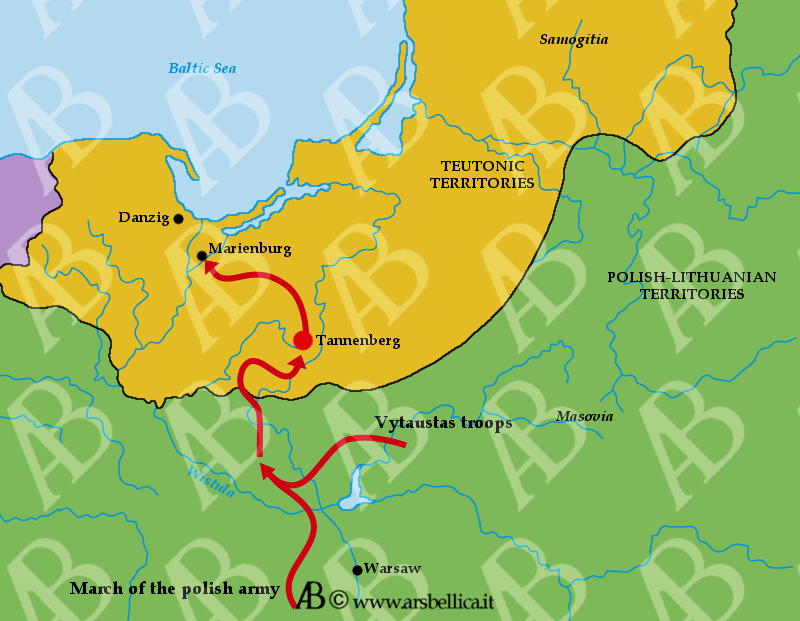
As already pointed out in previous battles (see Poitiers and Hastings), it was a true medieval institution, with strong Germanic and latin traditions. It plugs into the society of the time with an organization that is reminiscent of the Arts and corporations.
The society was then simplified and divided into three parts: oratores i.e. those who pray (clergy), bellatores (the Knights) and laboratores (peasants and artisans). Coming back for a moment to the ancient Germanic figure of the knight, we must stress that originally: the young warriors of each noble family undertook an oath to fight and die for their leader, and to use force to defend themselves and the honour of his people or his family.
Afterwards, this figure of a violent Warrior, using force as and when desired, is mitigated by Christian principles, which transformed the Knight arms men's men voted to an ideal.
The truce, the St. Alban's Pontifical (requiring use of the sword as a defense for widows, orphans, the churches and all the servants of God) and finally the Crusades contributed to sanctify the Knight figure and impose costumes that diluted its savagery, to follow the ideals of Christian piety.
TANNENBERG
Following the Crusades, had born the monastic-chivalric orders, which became peculiar institutions of Europe as a whole.
The members of these orders had to make a vow of chastity, obedience and poverty, but not only. In addition to these there was another vote, or rather, an oath which agreed them to fight and die for the cross, and offer assistance to the pilgrims in the Holy land.
In 1113, Pope Paschal II, recognized the rule of the Order of the Knights Hospitaller of St. John (now known as the Knights of Malta), in 1119 Hugh of Payens founded the Templar order arousing the enthusiasm of Bernard of Clairvaux, and in 1198 the Teutonic order was the protagonist of the battle of Tannenberg as well as many previous conflicts in the Baltic area.
TANNENBERG
The battle of Tannenberg, was perhaps one of the first battles in which were taken the first rudimentary firearms. As early as 1325, in Germany, they were producing "fire Mouths" forged with iron. It was actually by metal rods bottle shaped that mainly fired darts. During the 15th century, these rudimentary firearms were perfected and changed so much that were built the first siege artillery like cannons from 850 mm and guns (which were howitzers from the term houfnice in Czech) at a ratio of 1 to 4 between the caliber and barrel length. The heaviness of these pieces had to be monstrous camp, saw that it was very difficult to drive them and had to constantly be lean or even forks on shields.
In practice this is a revolution from the military point of view, becuse "relief" a huge emphasis on cavalry. Even the simplest infantry with one of those famous "cane fire" was able to kill a well-trained heavy Knight. We certainly do not give sense of turning point to these inventions: in recent years, it still had a quite experimental character. Not infrequently happened that this machinery jam, or even explode, killing the same Cannon crew, while, in terms of range, hardly exceeded the 250 meters.
In conclusion, the real crisis of heavy cavalry, was caused not only by artillery of that recent years, but more by the famous departments of Longbowmen (the Longbowmen of Azincourt), which throughout the hundred years war brought the French feudal Cavalry, as all the chivalries in Europe, in crisis as long as the solid Swiss Pikemen formations.
Also the infantry had undergone great changes in those years. The increased use of mercenaries (i.e. professional soldiers) as Pikemen, Crossbowmen and the increased field fortifications technique, such as Palisades, ditches, embankments and the ever-increasing ability to maneuver of dense masses of men, gave a very different appearance to those troops.
In the early Middle Ages had not a greatappearance, like summarily equipped formations, deployed and placed on the battlefield with a secondary task: give the coup de Grâce to the dismounted knights. But with time, the compact and manoeuvrable dismounted formations, combined with a thin but effective firepower could overshadow the impact power of heavy cavalry.
Tannenberg represents one of the last occasions when the use of light and heavy chivalries, proved to be decisive.
TANNENBERG
Military art and tactics of those years were basically that classic of all ages. Deployments were always in linear type (or "hedge") while the decisive weapon was the Cavalry, that if couldn't won at the first impact, forced its members to engage in fights between individuals which decimated the troops.
The tactics and the manoeuvres were very limited because focus all on knights units, there was only one way to make the better against enemy forces: the front charge. On the other hand also the territories chosen to fight had to be as fit as possible to the fighters with horses, so the places where they fought were always open and plans.
Although we have news of Tannenberg resistance of foot soldiers opposed to chivalries, dismounted troops acted yet subordinate, as well as the artillery that had not yet taken an entirely decisive importance. Briefly, this battlefield remains as an one example of the lasts in which the protagonists were feudal chivalries, considering that as at Crécy in 1346 and Agincourt in 1415, the decisive weapon (for the English in this case) it was the infantry.

The cavalries attacking system still works in separate times, or rather in "waves": there was first the charge of vanguard units, followed by more "heavy" departments which followed another charge by other light knights. Behind these were infantry formations as Pikemen and Crossbowmen, chosen from among the dismounted subofficiers. In some cases were adopted wedge formations, where at the Center was placed the less heavily armoured cavalry (formation of typical Norman matrix reused even in battles of World War II by some German generals with tank and wermarcht) and on the flanks the heavier cavalry.
The Knights will regroup in the usual units, consisting of a variable number of men on horseback: the heavy Knight, the squire, the page and possibly some archers; this units formed the "flags" or "bands", and in turn the bands formed the "companies".
TANNENBERG

Almost at the end of the 14th century, the geo-strategic situation of the Baltic States suffered a serious jolt. When the crowns of Denmark, Norway and Sweden gathered all over the head of Henry XIII, the Hanseatic towns, worried by the rise of this new and powerful ruler, sought protection, by binding to the Teutonic Order (the Grand Master of the Knights bore the title of protector of the League).
With this situation, many Baltic cities were losing importance in favour of those hanesatics, endangering the established balance in the territories. To prevent a socio-economic crisis in the country, the Knights tried again to conquer the Lithuanian Samogitia: a strip of land separating the eastern from the western part of the territory belonging to the order.
The project of conquest took greater force when, in 1407, was elected as grand master Ulrich von Jungingen1. The conquest became real when in 1409, the Teutonic army occupied the Polish lands of Dobrin and the powerful castle system which defended it. This maneuver was made only to "ensure" the side during their march towards the Lithuanian territories before mentioned and to not risk of being attacked by surprise by the same Poles.
But this aggression generated a not hoped alliance against the Grand Master: the Alliance between the Duke of Lithuania Vytautas and his cousin Vladislaus II Jagiellon King of Poland.
1 The figure of Ulrich von Jungingen, appears on the scene just three years before the battle of Tannenberg. Its guidelines and its political-military actions on the one hand, let think about a minimum awareness of "historical trends" of the Baltic area (and the objectives of the Church concerning the eastern lands), but on the other hand he proved to be a man of the past who blindly followed a code of honor passed long ago.
TANNENBERG
The technical progress made in the metallurgy began to impact strongly on the art of war. In recent decades the famous medieval chainmail, very common in the 12th and 13th centuries, is almost completely gone, not for its wearability (it was very practical and adaptable), but just because it now offered little shelter from bullets or blunt arms. Nearly all armour, were composed of a breastplate and a spine that were tied over his shoulders, and held together by sturdy straps on the sides; protective plates were even at the height of the heart (Brutschild), bracelets that protected the upper limbs, boots and leggings that protected the thighs and legs.
Having regard to the great protection offered by the armour, shields had become much smaller, and many helmets were no longer Topsfshelm type (i.e. "great helm") just anatomical, but had become much more complex and efficient as a fully visored hats, among the simplest forms, or borgognotte, among the most complex.
The weapons of offense were, for the infantry, the usual lances accompanied by swords, whose length varied from 90 to 150 cm. In particular the latter, established in the 15th century, it was used to break the enemy Pikes and get so off among the infantry. The first Knights combined this the usual weapons with the used of arms such as the mace and the scourge (known as Morgenstern "morning star"). These were formed by one or more blunt instruments attached to the handle by many chains, and were used to smash the enemy armour and helmet by vibrating a shot called "soprammano", i.e. from top to bottom, suitable for who could ride a horse.
TANNENBERG
For the lands of Dobrin was not necessary to raise an army of great proportions, as, on the other hand, wasn't possible to do the same for the entire conquest of Samogitia in Lithuania. It was necessary, for the Grand Master, wait for the arrival of reinforcements, represented by German knights spread across Europe and mercenaries promptly hired.

This expectation "brought" to an army that could count on 20,000 men so divided: 700 knights were "brothers" (on 1,400 present across Europe); 11,000 were "mobilized" recruited among peasants territories and cities (horse troops and contingents of peasant infantry); and finally were realized at least 8,000 among mercenaries and "Crusaders", volunteers who had flocked from Western Europe to the rescue.
On the other side Vladislaus and Vytaustas chose to reunite their forces rather than divide and attack the Templars on two fronts. The Union of the two armies took place on the northern shore of the Vistula River, just north of Warsaw. The Polish-Lithuanian forces aimed straight at Marienbug, the Teutonic capital. This advance was now "hindered" by the Templars, who diverted the path forcing the anti-Teutonic forces to cross the river Drweca safely anywhere else other than established.

The forces which the two Kings could count on, were numerically superior to the Templars one: 30,000. This army included: Lithuanians, Poles, Bohemians, Magyars (Hungarians), Moldovans, Russians of Smolensk and Tatar mercenaries. The highlight was definitely the Polish armoured Cavalry, which besides being perfectly army was really devoted to his King and "because". All other troops, were homogenous for fidelity (great) and armament (much less great); it is sufficient to say that the Grand Master, before the clash, had sent to his opponent two swords as "ironic contributed" to the armament of the Polish forces.
TANNENBERG
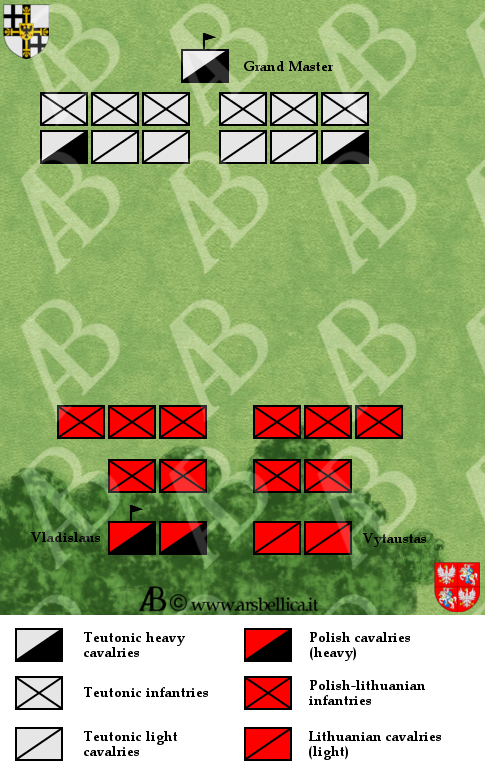
The two armies were deployed on 15 July 1410 between the towns of Tannenberg and Grunwald in southern Poland.
At the first light in the morning from Polish-Lithuanian camp sought colorful flags from North: the Teutonic army had finally arrived. Vladislaus then move from the field and deploy his troops.
The Battlefront was almost two and a half kilometres. The Polish-Lithuanian army was formed by numerous infantry, composed almost entirely of aggressive but badly organized farmers. The army was deployed in three rows with the right wing formed from Lithuanians, Russians and Tatars led by Vytaustas, and the left wing with poles, Bohemians and Moldovans led by Vladislaus.
The Templars, at first, sided with a formation almost mirroring the opponents, but their ranks were less numerous than those in Poland, then shorter. The Grand Master remodeled deployment, arranging his troops on two much larger lines, with the cavalry in the front row and the infantry with archers on the second.
The right wing was commanded by Grosskomtur (Conrad von Lichtenstein), the left was under the Prussian Marshal Friedrich von Wallenrode, while behind both lines were a dozen of infantrymen and Knights prepared to protect the Grand Master.
Both sides featured without artilleries considering that the rain would prevent the performance, and the slow soil will not facilitated certain movements.
The real battle began at nine o'clock in the morning.
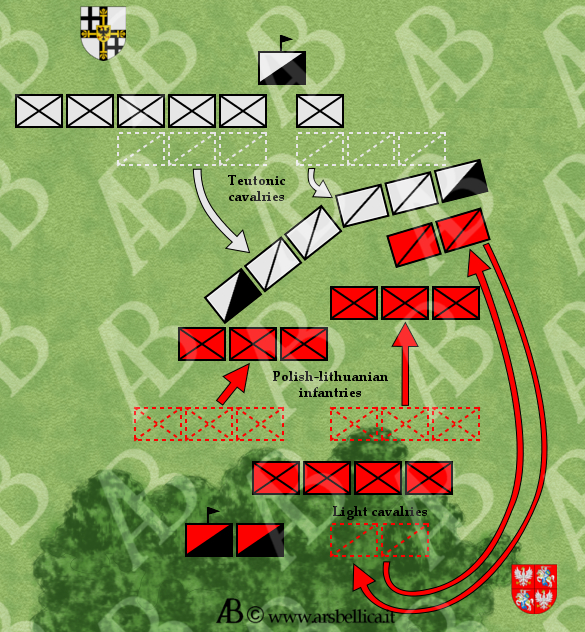
The first to move was the Lithuanian Light Cavalry, but was repulsed immediately against the Allied infantry of the Russians and Tatars whose files were messy.
The right wing of the Poles was so unprotected, making necessary to intervene the reserve infantry, as to stem the advance of Teutonic warriors from that side.
On the other hand the Templars, seeing the favorable situation on their left flank, moved more troops there, discovering in turn their right side. The error of this move was that the heavy Templar chivalries couldn't reach the faster Lithuanian horse troops, which retreated into the forest, by reforming itself next to the Polish heavy cavalry.
Meanwhile, the Knights had lost the space to charge even against dismounted enemies. Thus, the advancing Russian infantry engaged the Teutonic Knights in a scrum, while inconclusive, as risky for them. The strategic retreat by Vladislaus and concocted Vytaustas had brought the hoped results: Templar Cavalry had been blocked, the enemy infantry were discovered, and the inertia of the battle was in favor of the poles. But to win, should outperform in a charge the infantry of Grand Master and then stick it behind the cavalry engaged in melee.
Then Vladislaus launched the charge of his cavalry.

Although overshadowed in number, the brothers of the order, screaming 'Christ ist erstanden"(Christ has risen), managed to withstand incredibly the impact and even to reject the Polish Knights. In retreat, the Poles, saw reappear the heavy enemy chivalries that, meanwhile, had been freed themselves from the fray by slaughter and routing the Russian infantry. The advantage gained by the first action, as well as the favorable opportunity was escaping by Polish hands.
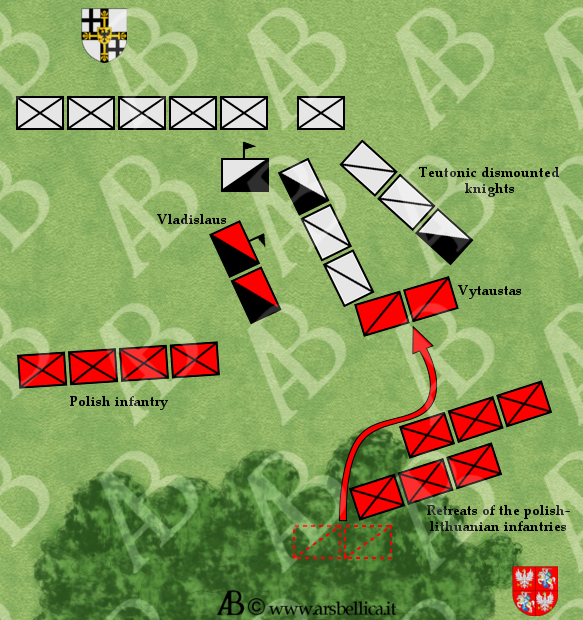
The Polish King decided it was the right time to attack the enemy's wings one at a time.
He led his cavalry against the Teutonic chivalries and let came out from the Woods, where it had taken refuge, the light cavalry of Vytaustas, who charged on the right flank Cavalry units of the order before they reaggregate with the Grand Master, who rushed to their aid. But the Templar horses were exhausted for sustained efforts in the last melee and were unable to launch in a countercharge: for poles and Lithuanians was easy to make slaughter of the enemy Knights.
Just after the massacre of the confreres who still had a horse, Vladislaus was able to advance the Polish infantry, so far unused, to return to Russian ones, riorganized after the retreat, and finally focus almost exclusively on the remaining the Teutonic infantry forces. At this point lost their lives almost all the senior officers of the order including the Grand Master, the Grand Treasurer and Grosskomtur.
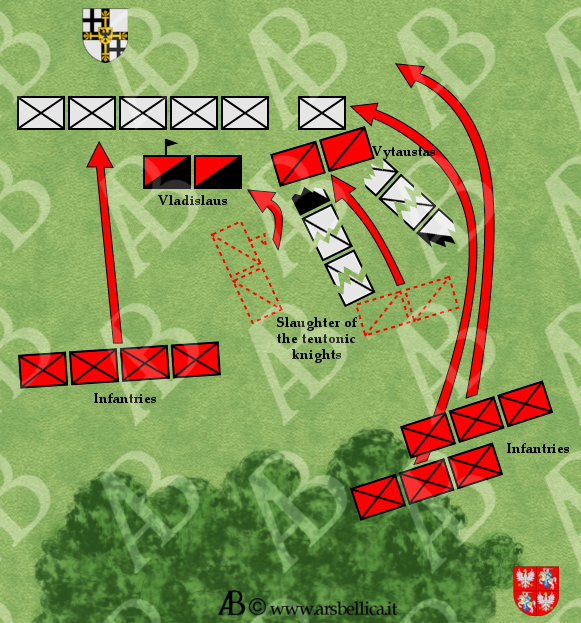
The battle had lasted nine hours, many of which were passed in very violent clashes with white weapons. The sergeants and the remaining dismounted knights were massacred, few were prisoners. The day after the battle, Vladislaus did gather from the battlefield 51 insignia of his enemies, who were placed in the chapel of Saint Stanislaus of the Wawel Cathedral in Krakow, nowadays however went all lost.
TANNENBERG
The defeat suffered at Tannenberg, get the order in a crisis so serious that the number of mercenaries hired to defend their territories as a result of that defeat, was increasing. In 1511, was consolidated in the territories of the order, the power of Albert of Brandenburg, who became in effect the first Grand Master. The Hohenzollern inherited those territories, converted to Lutheranism (as the rest of Prussia) and after the war of the Spanish succession would become rulers in Germany until 1918.

The Teutonic Knights survived and moved to Vienna, where they still resides. His knights fought for the Habsburgs during the siege of Vienna (1683) and Zenta in 1695. Napoleon disbanded the order in 1809, but it was restored in 1840; from 1929 is under the protection of the Vatican and recently opened a representative office in Rome.

The battle of Tannenberg went on for centuries the Slavic and Germanic nationalist pride. It is sufficient to say that during the first world war, the German general Von Hindemburg defeated on the same field the Russian colleague Samsonov (26-30 August 1914). For the shame of the defeat Samsonov suicide; while the German propaganda presented this win as "revenge" for the defeat suffered five centuries before. At that battle, the nationalsocialists germans erected a monument, destroyed by the Poles just back off, re-using the stones of that for another monument in Warsaw of opposite sign.
In addition to the value of the Polish people in the ancient battle, it should be recognized as the Christian Action of the Order in Poland did the same a sort of bastion of Catholicism, and then today, they recognized the merits of the brethren of the Teutonic Order.
TANNENBERG
The defeat at Tannenberg marks the arrest of Teutonic expansion eastward. If Vladislaus was beated in that battle, the defeated would have witnessed the slow "colonization" of Lithuanian and Polish territories by the order that, as was their custom, would slowly "germanized" those territories. But what should be noted is the fact that the demarcation line separating the Slavic peoples from the Germanic ones should have been moving more and more towards the East and the South, with very important consequences on the current geography. The borders of Germany were much more extensive than current ones, all at the expense of Poland 's territorial.